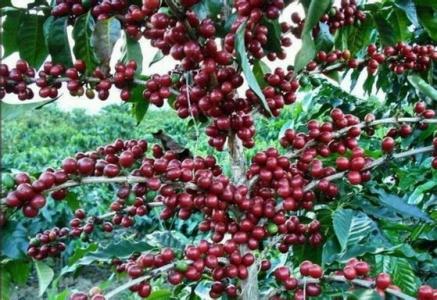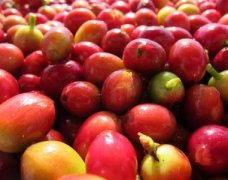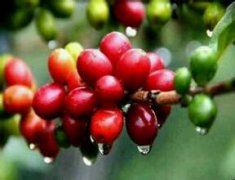Costa Rican black honey treats boutique coffee beans from Faramy Manor in Kaduetara production area.

Factory name: coffee factory address: No. 10 Baoqian Street, Yuexiu District, Guangzhou City, shelf life: 90 net content: 227g packing: raw and ripe coffee beans in bulk: whether coffee beans contain sugar: sugar-free origin: Costa Rica roasting degree: moderate roasting
Country: Costa Rica
Grade: SHB
Producing area: Tarazhu
Baking degree: medium baking
Treatment method: black honey treatment
Variety: Kaduai
Manor: Faramy Manor
Flavor: preserved plum, honey, brown sugar
Although Costa Rica has won the recognition of coffee gluttons through honey-treated coffee beans, it is also closely related to Costa Rica's superior geographical and climatic conditions, and the selection of Arabica varieties of coffee. Costa Rica's high-quality coffee beans are called "very hard beans" (SHB), and the quality of hard beans (HB) and slightly hard beans (SH) decline in turn, and this is also the way it is graded. Extremely hard beans grow at an altitude of more than 1500 meters, and altitude always represents the quality of coffee, and high altitude means better quality. In addition, due to the high altitude drop caused by sufficient rainfall, is very beneficial to the growth of coffee trees; and high altitude night temperature is low, resulting in slow growth of trees, so that coffee fruit better absorb more nutrients, coffee flavor is also richer.
Its three most famous producing areas are Tarasu, south of the Costa Rican capital SanJose, as well as the producing areas of the Central Valley and the western valley. There are many excellent independent estates, all of which are carefully cultivating more fine washed and honey-treated coffee beans. let's hope that Costa Rica will bring us more honey-treated coffee surprises.
We usually see the treatment of honey: yellow honey, red honey, black honey.
Yellow honey: about 40% of the pectin is removed; the drying method requires the most direct heat absorption, receives the most light drying, and lasts for about 8 days to reach a stable water content.
Red honey: about 25% of the pectin is removed; it takes longer to dry than yellow honey, and reduces direct exposure to sunlight, even in shading sheds, lasting about 12 days.
Black honey: hardly remove pectin; dry for the longest time, lasting at least 2 weeks, with a cover to avoid too strong sunlight, prevent drying too fast, and make sugar conversion more fully.
This batch of Ferrari Manor Black Honey treatment, the famous Tarasu from Costa Rica, started late in the development of boutique coffee, but now Costa Rican boutique coffee is developing rapidly. with the mild acidity of honey treatment, soft taste and sweet high-quality berry flavor, it is not to be underestimated. Black honey retains about 80% of the pectin pulp. The most obvious difference between them is that yellow, red and black are sweeter than the other. Coupled with the rich fruit rhyme, it is deeply loved by all the coffee gluttons.
Flavor: plum, honey, brown sugar, orange blossom, white chocolate
Taste: good sweetness, soft acidity, round and full, long-lasting finish.
Important Notice :
前街咖啡 FrontStreet Coffee has moved to new addredd:
FrontStreet Coffee Address: 315,Donghua East Road,GuangZhou
Tel:020 38364473
- Prev

Qianjie honey boutique coffee beans Ethiopian water washed Sidamo G1 imported micro-batch fresh baking
Factory name: coffee factory address: Guangzhou Yuexiu Guan District Baoqian Street 10 Qianjie coffee manufacturers contact information: 38364473 shelf life: 90 net content: 227g packaging: raw maturity of bulk coffee beans: whether coffee beans contain sugar: sugar-free origin: Ethiopia roasting degree: light roasting various coffee cultivation methods can be found in Ethiopia: from slices of wild coffee
- Next

The front street Panamanian Poket butterfly coffee beans contain 70% rosy summer.
Country: Panama Grade: SHB production area: Boquete Baking degree: medium Baking method: washed varieties: Kaddura, Kaduai, Rose Summer Flavor: tea, Honey, berries, Classic Jade Manor Panama belongs to Central American countries, bordering Costa Rica to the west and Colombia to the east. Anyone who knows anything about individual coffee should know, Bana.
Related
- Detailed explanation of Jadeite planting Land in Panamanian Jadeite Manor introduction to the grading system of Jadeite competitive bidding, Red bid, Green bid and Rose Summer
- Story of Coffee planting in Brenka region of Costa Rica Stonehenge Manor anaerobic heavy honey treatment of flavor mouth
- What's on the barrel of Blue Mountain Coffee beans?
- Can American coffee also pull flowers? How to use hot American style to pull out a good-looking pattern?
- Can you make a cold extract with coffee beans? What is the right proportion for cold-extracted coffee formula?
- Indonesian PWN Gold Mandrine Coffee Origin Features Flavor How to Chong? Mandolin coffee is American.
- A brief introduction to the flavor characteristics of Brazilian yellow bourbon coffee beans
- What is the effect of different water quality on the flavor of cold-extracted coffee? What kind of water is best for brewing coffee?
- Why do you think of Rose Summer whenever you mention Panamanian coffee?
- Introduction to the characteristics of authentic blue mountain coffee bean producing areas? What is the CIB Coffee Authority in Jamaica?

